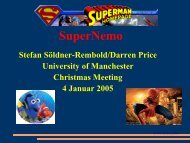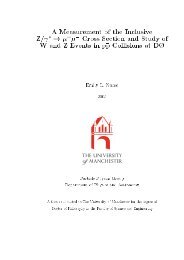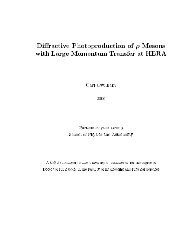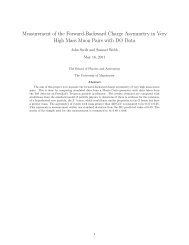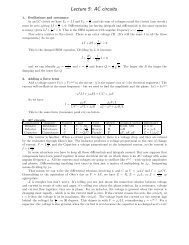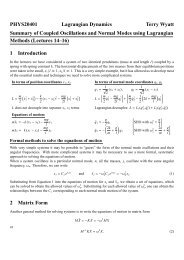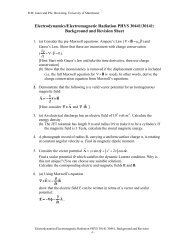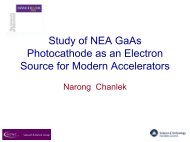ZGOUBI USERS' GUIDE - HEP
ZGOUBI USERS' GUIDE - HEP
ZGOUBI USERS' GUIDE - HEP
- No tags were found...
You also want an ePaper? Increase the reach of your titles
YUMPU automatically turns print PDFs into web optimized ePapers that Google loves.
4.6 Complementary Features 135¢ww@¢·€ï€¢§¢§Polar CoordinatesIf q KPOS , the element is positioned automatically in such a way that a particle entering with zero initial coordinates ¥ ¡., ¡ ! 1 !2and relative momentum will reach position ( , Z >) in the element with \angle withq Orespect to the moving frame in the polar coordinates system of the element (Fig. 44; see DIPOLE-M and POLARMES).If 1 KPOS the map is positioned in such a way that the incoming reference frame is presented at radius with angle". The exit reference frame of zgoubi is positioned in a similar way with respect to the map, by means of the twoparameters (radius) and (angle) (see Fig. 10A.).1|¢ · 14.6.6 Coded integration stepIn several optical elements (e.g., all multipoles, BEND) the integration step (in general noted XPAS) can be coded underthe form XPAS = b.fffE10 in order to allow two different step sizes in the uniform part of the field (the optical elementbody) and in the field fall-off regions. b is an arbitrary integer and fff is a 3-digit integer; they give the number of stepsrespectively in the body and fringe field regions. For instance 120.012E10 requests 120 steps in the body and 12 in thefringe field regions. The maximum allowed value for fff is 999 steps.4.6.7 Ray-tracing of an arbitrarily large number of particlesMonte Carlo multiparticle simulations involving an arbitrary number of particles can be performed by means of REBE-LOTE, put at the end of the optical structure, with its argument NPASS being the number of passes through REBELOTE,and (NPASS q ) * IMAX the number of particles to be ray-traced. In order that new initial conditions (O , , , , ¥ ,§ ) be generated at each pass, Ñ C\has to be specified in REBELOTE.Statistics on coordinates, spins, and other histograms can be performed by means of such procedures as HISTO, SPNTRK,etc. that stack the information from pass to pass.4.6.8 Stopped particles: the IEX flagAs described in OBJET, each particle ¤ Under certain circumstances, IEX may take negative values, as followsq , IMAX is attached a value ¤¤ of the IEX flag. Normally, ¤¤ q .: too many integration steps in an optical elementq : the trajectory happened to wander outside the limits of a field mapw @: deviation happened to exceed ©@ in an optical elementw U: stopped by walls (procedures CHAMBR, COLLIMA)w*R: too many iterations in subroutine DEPLAw N: energy loss exceeds particle energyw G: field discontinuities larger than 50% wthin a field map¦: reached field limit in an optical elementw ”Only in the ¤ § wq case will the integration not be stopped since in this case the field outside the map is extrapolatedfrom the map data, and the particle may possibly get back into the map (see section 1.4.2 on page 21). In all other casesthe particle of concern will be stopped.4.6.9 Negative rigidityzgoubi can handle negative rigidities ¡.,ï \), or counter going particles (\), or virtually reversed fields (w.r.t. the field sign that shows in the optical(element data list).Negative rigidities may be specified in terms of ! 1 ! ï\or O ¡-, ¡ ! 1 ! ï†\when defining the initial coordinateswith OBJET and MCOBJET.¡Ÿ . This is equivalent to considering either particles of negative charges




